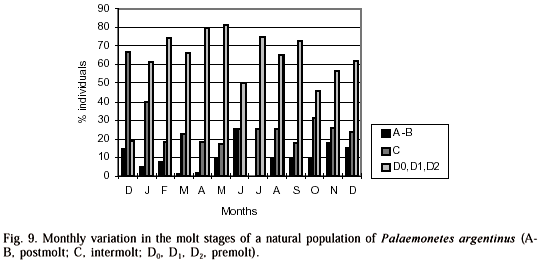The molt cycle of the natural population of Palaemonetes argentinus Nobili, 1901 from Los Padres Lagoon, Buenos Aires, Argentina, was studied in relation to age, sex, and environmental factors. A total of 1645 individuals (740 females, 539 males, and 366 juveniles) were collected and analyzed between December 1995 and December 1996. The results indicate that the sex ratio (males:females) remains around 1:1.4 throughout most of the year. The reproductive period extends from September until February (spring and summer), with maximum sexual activity in October and November. Two cohorts originated in the spring and in the summer were differentiated. Ovigerous females arrest their molt cycle during the intermolt period to restart it after oviposition. The duration of the intermolt period does not differ between adults and juveniles. Since the percentage of premolt individuals represents 60% of the total cycle, it was classified as a diecdysic cycle. Within the studied range of water temperatures, the observed variations in the span of the different stages, indicate that this factor does not alter the molt frequency. Like in the rest of decapods, the intermolt duration of P. argentinus is modified by ovarian maturation.
Palaemonetes; Decapoda; Palaemonidae; molt cycle; ovarian maturation












